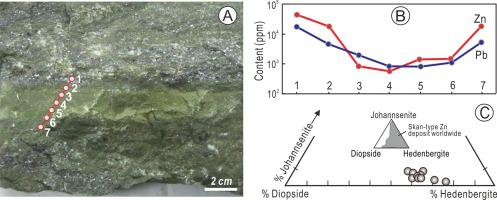当前位置:
X-MOL 学术
›
Ore Geol. Rev.
›
论文详情
Our official English website, www.x-mol.net, welcomes your
feedback! (Note: you will need to create a separate account there.)
Stratabound skarn Pb-Zn mineralization in the Yunkai Domain (South China): the Fozichong case
Ore Geology Reviews ( IF 3.2 ) Pub Date : 2020-10-01 , DOI: 10.1016/j.oregeorev.2020.103673 Peng-Peng Yu , Yi Zheng , Xi Huang , Cheng-Ming Wang
Ore Geology Reviews ( IF 3.2 ) Pub Date : 2020-10-01 , DOI: 10.1016/j.oregeorev.2020.103673 Peng-Peng Yu , Yi Zheng , Xi Huang , Cheng-Ming Wang

|
Abstract The Fozichong Pb-Zn ore district, located in the Yunkai Domain, southern section of the Qin-Hang Metallogenic Belt (QHMB) in South China, consists of several large-size stratabound ore deposits. The ore bodies are mainly stratiform and stratoid, bounded within the Ordovician and Silurian strata that are intruded by the Yanshanian porphyries. These deposits are debated between syngenetic sedimentary exhalative (SEDEX)- and epigenetic skarn-type. Since the occurrence of ore bodies is accompanied by the green-color stratiform rock (GSR), the GSR origin may play an important role to resolve the controversy. This motivates us to conduct a set of petrographic investigations, whole-rock and mineral chemistry analyses of the GSR coupled with zircon U–Pb geochronology of the intrusions. Detailed petrographic observations reveal that the GSR is mainly composed of a mineral assemblage of garnet, pyroxene, epidote, amphibole and chlorite, in analogy with that of traditional skarns. In addition, the concentrations of ore-related Pb, Zn, Cu and Ba consistently decrease from rim to core of an individual GSR layer, supporting an origin of hydrothermal fluid replacement rather than comparatively homogeneous sedimentation. Therefore, the Fozichong GSR is referred to as the stratiform skarn in literature. The Mn-poor and Ca-rich andradite, diopside-hedenbergite and calcic amphibole in the skarn provide robust evidence for the magmatic hydrothermal origin. The skarn is believed to be formed by the infiltration of magmatic hydrothermal fluids since it is not confined in the intrusion contact zone. Where the hydrothermal fluids derived from is complicated due to the multi-stages magmatic intrusions present in the district. Detailed investigations indicate that the late Yanshanian porphyries (zircon U–Pb dated at ~ 100 Ma, including dacite porphyry and granite porphyry) have a genetic link with the Fozichong skarn mineralization, while the Indosinian Dachong pluton and the early Yanshanian Guangping pluton exhibit insignificant correlation with the mineralization. The redox state of the skarn system changes from oxidation (prograde and retrograde stages) to reduction (late retrograde and quartz-sulfide stages), as recorded by the Fe2+/Fe3+ ratios in skarn minerals (i.e., 0.05 for garnet, 0.01–0.23 for amphibole and 55.6–178.1 for chlorite, respectively). During the redox transition, the mineralization has been developed with the precipitation of chlorite at moderate temperatures (~255 to 278 °C). In combined with the above analyses, the Fozichong is representative of a stratabound skarn Pb-Zn mineralization system in the Yunkai Domain, South China.
中文翻译:

云开域(华南)层状矽卡岩铅锌矿化:佛子冲案例
摘要 佛子冲铅锌矿区位于华南秦杭成矿带(QHMB)南段云开域,由数个大型层状矿床组成。矿体以层状和层状为主,边界在燕山期斑岩侵入的奥陶系和志留系地层内。这些沉积物在同生沉积喷出物 (SEDEX) 和表生矽卡岩型之间存在争议。由于矿体的出现伴随着绿色层状岩(GSR),因此GSR成因可能对解决这一争议起到重要作用。这促使我们对 GSR 进行一系列岩石学研究、全岩和矿物化学分析,并结合侵入体的锆石 U-Pb 年代学。详细的岩相观察表明,GSR 主要由石榴石、辉石、绿帘石、角闪石和绿泥石组成的矿物组合,与传统矽卡岩类似。此外,与矿石相关的 Pb、Zn、Cu 和 Ba 的浓度从单个 GSR 层的边缘到核心持续降低,支持热液置换的起源,而不是相对均匀的沉积。因此,佛子冲GSR在文献中被称为层状矽卡岩。矽卡岩中贫锰和富钙的红霞石、透辉石-菱镁矿和钙质角闪石为岩浆热液成因提供了有力的证据。矽卡岩被认为是由岩浆热液渗入形成的,因为它不受侵入接触带的限制。由于该地区存在多级岩浆侵入,热液来源复杂。详细调查表明,燕山晚期斑岩(锆石U-Pb年代在~100 Ma,包括英安斑岩和花岗斑岩)与佛子冲矽卡岩成矿存在成因联系,而印支期大冲岩体与燕山早期广坪岩体的相关性不显着随着矿化。矽卡岩系统的氧化还原状态从氧化(顺行和逆行阶段)转变为还原(晚期逆行和石英-硫化物阶段),如矽卡岩矿物中的 Fe2+/Fe3+ 比率记录(即石榴石为 0.05,石榴石为 0.01-0.23)。闪石和亚氯酸盐分别为 55.6–178.1)。在氧化还原转变过程中,随着绿泥石在中等温度(~255 至 278 °C)下沉淀,矿化作用得以发展。综合以上分析,佛子冲代表了华南云开域层控矽卡岩铅锌矿化体系。
更新日期:2020-10-01
中文翻译:

云开域(华南)层状矽卡岩铅锌矿化:佛子冲案例
摘要 佛子冲铅锌矿区位于华南秦杭成矿带(QHMB)南段云开域,由数个大型层状矿床组成。矿体以层状和层状为主,边界在燕山期斑岩侵入的奥陶系和志留系地层内。这些沉积物在同生沉积喷出物 (SEDEX) 和表生矽卡岩型之间存在争议。由于矿体的出现伴随着绿色层状岩(GSR),因此GSR成因可能对解决这一争议起到重要作用。这促使我们对 GSR 进行一系列岩石学研究、全岩和矿物化学分析,并结合侵入体的锆石 U-Pb 年代学。详细的岩相观察表明,GSR 主要由石榴石、辉石、绿帘石、角闪石和绿泥石组成的矿物组合,与传统矽卡岩类似。此外,与矿石相关的 Pb、Zn、Cu 和 Ba 的浓度从单个 GSR 层的边缘到核心持续降低,支持热液置换的起源,而不是相对均匀的沉积。因此,佛子冲GSR在文献中被称为层状矽卡岩。矽卡岩中贫锰和富钙的红霞石、透辉石-菱镁矿和钙质角闪石为岩浆热液成因提供了有力的证据。矽卡岩被认为是由岩浆热液渗入形成的,因为它不受侵入接触带的限制。由于该地区存在多级岩浆侵入,热液来源复杂。详细调查表明,燕山晚期斑岩(锆石U-Pb年代在~100 Ma,包括英安斑岩和花岗斑岩)与佛子冲矽卡岩成矿存在成因联系,而印支期大冲岩体与燕山早期广坪岩体的相关性不显着随着矿化。矽卡岩系统的氧化还原状态从氧化(顺行和逆行阶段)转变为还原(晚期逆行和石英-硫化物阶段),如矽卡岩矿物中的 Fe2+/Fe3+ 比率记录(即石榴石为 0.05,石榴石为 0.01-0.23)。闪石和亚氯酸盐分别为 55.6–178.1)。在氧化还原转变过程中,随着绿泥石在中等温度(~255 至 278 °C)下沉淀,矿化作用得以发展。综合以上分析,佛子冲代表了华南云开域层控矽卡岩铅锌矿化体系。











































 京公网安备 11010802027423号
京公网安备 11010802027423号